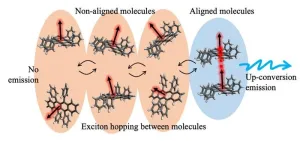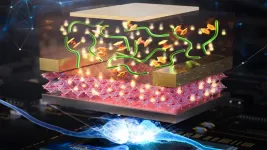(Press-News.org) U.S. veterans of the wars in Afghanistan and Iraq who suffered mild traumatic brain injury from exposure to explosive blasts were found to have changes in cerebrospinal fluid proteins that are typically seen in people who develop Alzheimer’s disease, according to researchers at the University of Washington School of Medicine and VA Puget Sound Health Care System.
“While our research does not prove that veterans who experienced these injuries will develop Alzheimer’s disease, it raises the possibility that they may be on a pathway leading to dementia,” said Dr. Ge Li, the paper's first author and an associate professor of psychiatry and behavioral sciences at UW Medicine.
The study was published March 13 in the journal Neurology.
Previous research has found that sustaining a moderate to severe TBI increases a person’s risk of developing Alzheimer’s disease. It is not known, however, whether a mild TBI (mTBI) similarly increases this risk.
In the new study, the researchers analyzed protein levels in spinal fluid from 51 U.S. veterans of the wars in Afghanistan and Iraq. Each had suffered mTBIs from exposure to explosive blasts and had an average of 20 blast injuries. Those protein levels were compared with the protein levels of 85 veterans and civilians of similar age who had never sustained a TBI.
In this study, the veterans were considered to have experienced a TBI if they had an alteration or loss of consciousness from the blast. The TBIs were considered mild if the loss of consciousness lasted 30 minutes or less and there was no sign of brain damage on standard clinical MRI or CT scan. Such an injury is considered equivalent to a concussion.
The researchers examined protein levels in the veterans’ cerebrospinal fluid, which flows around and through the brain and carries away waste materials. Two of the proteins measured compose the chief components of amyloid plaques, which aggregate in the brains of people with Alzheimer’s. These proteins are called alpha-beta amyloid 40 and 42 (Aβ40, Aβ42).
The other proteins are versions of the tau protein. Normally, tau proteins are part of cells’ cytoskeletons, which give cells their shape. But with Alzheimer’s, these structures are changed, creating tangles within brain cells and killing them. This is the other hallmark of Alzheimer’s.
With Alzheimer’s disease, the levels of alpha-beta amyloid proteins in spinal fluid typically decrease. Researchers hypothesize that the proteins, instead of being flushed out into the spinal fluid and carried away as they normally would be, are deposited in amyloid plaques and remain in the brain. As the disease progresses, tau levels, in contrast, tend to be higher than normal, as the proteins are released from dying brain cells.
In the study, mTBI veterans in their late 40s and 50s had lower levels of beta-amyloid proteins, compared with the veterans and civilians who had not had such injuries.
Tau protein levels also were abnormal in the older mTBI veterans. Normally, tau levels rise as we age. But among the older middle-aged mTBI veterans, levels tended to remain the same, a finding that the normal brain clearance system may not be working as well in among the people with mTBI.
Among older mTBI veterans, having lower beta-amyloid 42 levels was also associated with doing less well on cognitive tests assessing verbal memory and fluency.
The decline in beta-amyloid proteins, in particular beta-amyloid 42, was concerning, said senior author Dr. Elaine Peskind, a UW research professor of psychiatry and director of the VA’s Northwest Mental Illness Research, Education, and Clinical Center.
“A decline in beta-amyloid 42 is the earliest detectable change due to Alzheimer’s that can be found in a cognitively normal person,” she said. “The change can appear as much as 20 years before symptoms. So a person can have the pathology of Alzheimer’s going on in their brain but still not have any symptoms — no problem with their memory or thinking functions — for as long as 20 years.”
Peskind and her collaborators suspect the cause of the changes in the mTBI veterans’ spinal fluid proteins is due to blast-related damage to a system in the brain, called the glymphatic system, that allows fluids to flow through the brain and carry away waste products. To find out, they have been funded by the National Institute of Neurological Diseases and Stroke to study the regulation and function of this system in veterans with these injuries.
END
Blast-related concussions linked to higher Alzheimer’s risk
Veterans who suffered these injuries were found to have changes in spinal fluid also seen in people who develop Alzheimer’s.
2024-03-14
ELSE PRESS RELEASES FROM THIS DATE:
Modest rise in UK cancer cases but substantial decline in deaths over last 25 years
2024-03-14
Cases of cancer among UK men and women aged 35-69 years have seen a modest rise over the last quarter of a century, but there has also been a substantial decline in death rates, finds a study published by The BMJ today.
The results show a fall in death rates for all cancers combined and for 17 out of 22 cancer types examined, which the researchers say is likely due to fewer people smoking, screening programmes, and improved treatment, while a rise in some less common cancers may be due to higher levels of overweight and obesity, ...
Cancer deaths plummet in middle-aged people
2024-03-14
A first of its kind study by Cancer Research UK reveals premature cancer death rates in 35–69-year-olds fell by more than a third over 25 years
Improvements in the UK are a result of smokefree policies, prevention measures, early detection programmes like cancer screening, and more effective treatment options
But the study paints a mixed picture with cancer cases on the rise and cancer mortality rates still too high
The charity’s manifesto, ‘Longer, ...
How to upcycle low-energy light
2024-03-14
To combine two low-energy photons into one high-energy photon efficiently, the energy must be able to hop freely, but not too quickly, between randomly oriented molecules of a solid. This Kobe University discovery provides a much-needed design guideline for developing materials for more efficient PV cells, displays, or even anti-cancer therapies.
Light of different colors has different energies and is therefore useful for very different things. For the development of more efficient PV cells, OLED displays, or anti-cancer therapies it is desirable to be able to upcycle two low-energy photons into a high-energy photon, ...
Lives could be saved from tropical disease with new rapid test
2024-03-14
Globally, more than half of patients die after infection with the neglected tropical disease, melioidosis, often before they are diagnosed1. A new rapid test could save lives by diagnosing patients in hours, rather than several days taken by current bacterial culture methods, meaning they receive the correct antibiotics faster.
The test uses CRISPR to detect a genetic target that is specific to Burkholderia pseudomallei, the bacterium that causes melioidosis, with 93 per cent sensitivity. It was ...
Revolutionary chronic wound treatment could help millions
2024-03-14
Revolutionary chronic wound treatment could help millions
A team of international scientists has developed an effective treatment for preventing infection in chronic wounds that does not involve antibiotics
The treatment involves the plasma (electrical gas) activation of hydrogel dressings to produce a unique mix of different chemical oxidants that applied to the wound are effective in decontaminating and aiding healing in chronic wounds
The new method is a significant advance that could revolutionise the treatment of diabetic foot ulcers and internal wounds
More than 540 million people ...
First-of-its-kind super minigene to boost spinal muscular atrophy research
2024-03-13
AMES, Iowa – Ravindra Singh has spent years studying a gene that when missing or mutated causes spinal muscular atrophy (SMA), a deadly disease that’s among the most common genetic disorders in children. His team’s latest work will make the search for treatments even more effective in the years to come.
Singh, a professor of biomedical science at Iowa State University, led an eight-year project to create a truncated version of the Survival Motor Neuron 2 (SMN2) gene to facilitate quicker, cheaper and less fragmented research. Nucleic Acids Research, a peer-reviewed ...
NYU Tandon study exposes failings of measures to prevent illegal content generation by text-to-image AI models
2024-03-13
Researchers at NYU Tandon School of Engineering have revealed critical shortcomings in recently proposed methods aimed at making powerful text-to-image generative AI systems safer for public use.
In a paper that will be presented at the Twelfth International Conference on Learning Representations (ICLR), taking place in Vienna on May 7 - 11, 2024, the research team demonstrates how techniques that claim to "erase" the ability of models like Stable Diffusion to generate explicit, copyrighted, or otherwise unsafe ...
New analysis shows tirzepatide consistently reduces bodyweight regardless of body mass index (BMI) before treatment
2024-03-13
*Note – this is an early press release from the European Congress on Obesity in Venice, Italy 12-15 May. Please credit the congress when using this research*
Tirzepatide, a medication authorised to treat obesity and/or type 2 diabetes, consistently reduces bodyweight regardless of the patient’s body mass index (BMI before treatment), from the range of overweight to class III obesity. The study, to be presented at this year’s European Congress on Obesity (Venice, Italy, 12-15 May) is by Prof Carel Le Roux, University ...
Tirzepatide reduces body weight and waist circumference in people living with overweight or obesity regardless of duration of their condition
2024-03-13
*Note – this is an early press release from the European Congress on Obesity in Venice, Italy 12-15 May. Please credit the congress when using this research*
New research to be presented at this year’s European Congress on Obesity (Venice, Italy, May 12-15) shows that the obesity medication tirzepatide consistently reduces bodyweight and waist circumference regardless of the length of time the person has been living with overweight or obesity. The study is by Dr Giovanna Muscogiuri, University of Naples Federico II, Naples, Italy, and colleagues.
Tirzepatide (Mounjaro®) was approved by the US Food and ...
Scientists use novel technique to create new energy-efficient microelectronic device
2024-03-13
Breakthrough could help lead to the development of new low-power semiconductors or quantum devices.
As the integrated circuits that power our electronic devices get more powerful, they are also getting smaller. This trend of microelectronics has only accelerated in recent years as scientists try to fit increasingly more semiconducting components on a chip.
Microelectronics face a key challenge because of their small size. To avoid overheating, microelectronics need to consume only a fraction of the electricity of conventional electronics while still operating at peak performance.
Researchers at the U.S. Department of Energy’s (DOE) Argonne National Laboratory ...
LAST 30 PRESS RELEASES:
Estimating unemployment rates with social media data
Climate policies can backfire by eroding “green” values, study finds
Too much screen time too soon? A*STAR study links infant screen exposure to brain changes and teen anxiety
Global psychiatry mourns Professor Dan Stein, visionary who transformed mental health science across Africa and beyond
KIST develops eco-friendly palladium recovery technology to safeguard resource security
Statins significantly reduce mortality risk for adults with diabetes, regardless of cardiovascular risk
Brain immune cells may drive more damage in females than males with Alzheimer’s
Evidence-based recommendations empower clinicians to manage epilepsy in pregnancy
Fungus turns bark beetles’ defenses against them
There are new antivirals being tested for herpesviruses. Scientists now know how they work
CDI scientist, colleagues author review of global burden of fungus Candida auris
How does stroke influence speech comprehension?
B cells transiently unlock their plasticity, risking lymphoma development
Advanced AI dodel predicts spoken language outcomes in deaf children after cochlear implants
Multimodal imaging-based cerebral blood flow prediction model development in simulated microgravity
Accelerated streaming subgraph matching framework is faster, more robust, and scalable
Gestational diabetes rose every year in the US since 2016
OHSU researchers find breast cancer drug boosts leukemia treatment
Fear and medical misinformation regarding risk of progression or recurrence among patients with breast cancer
Glucagonlike peptide-1 receptor agonists and asthma risk in adolescents with obesity
Reviving dormant immunity: Millimeter waves reprogram the immunosuppressive microenvironment to potentiate immunotherapy without obvious side effects
Safety decision-making for autonomous vehicles integrating passenger physiological states by fNIRS
Fires could emit more air pollution than previously estimated
A new way to map how cells choose their fate
Numbers in our sights affect how we perceive space
SIMJ announces global collaborative book project in commemoration of its 75th anniversary
Air pollution exposure and birth weight
Obstructive sleep apnea risk and mental health conditions among older adults
How talking slows eye movements behind the wheel
The Ceramic Society of Japan’s Oxoate Ceramics Research Association launches new international book project
[Press-News.org] Blast-related concussions linked to higher Alzheimer’s riskVeterans who suffered these injuries were found to have changes in spinal fluid also seen in people who develop Alzheimer’s.


